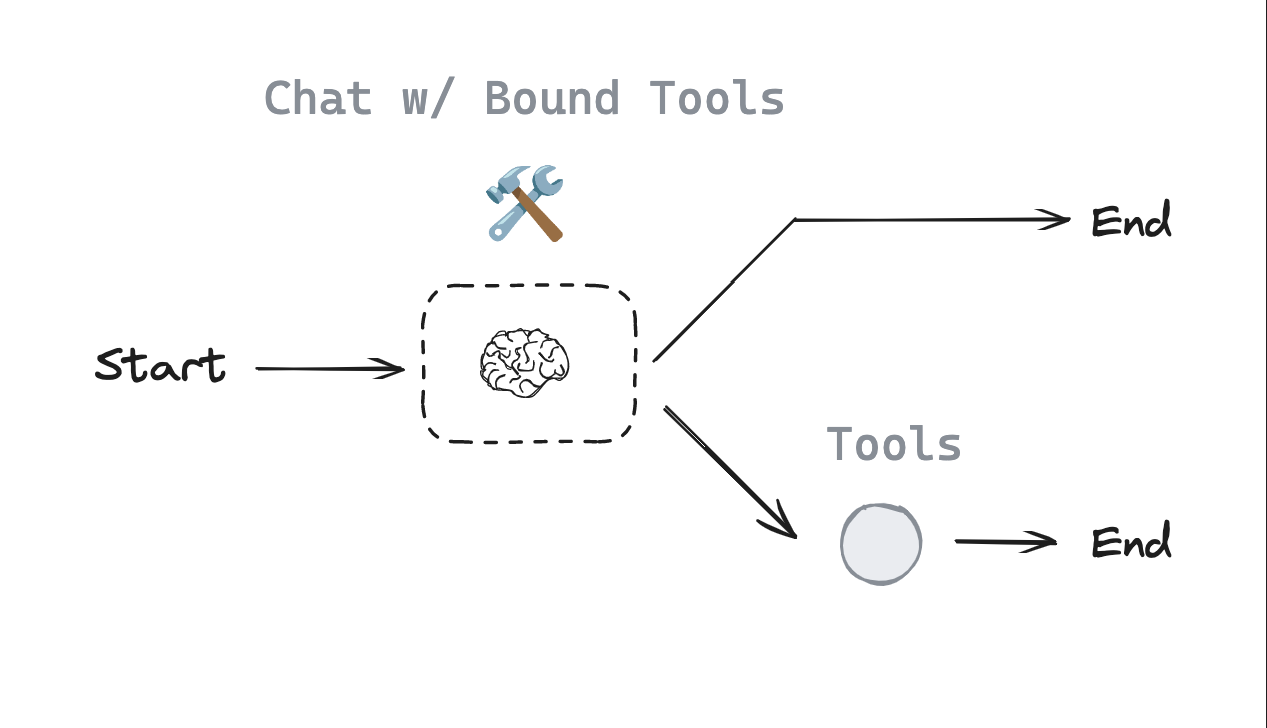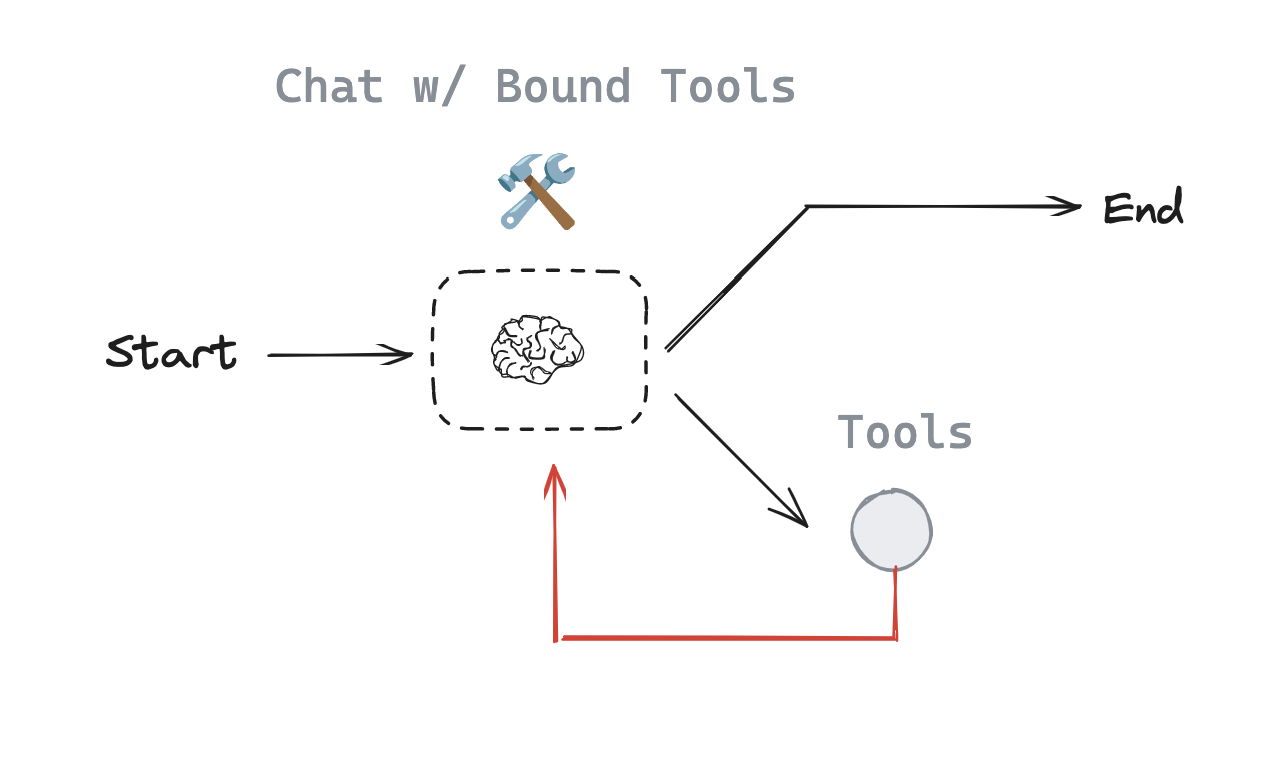智能体¶
回顾¶
我们构建了一个路由机制。
- 聊天模型将根据用户输入决定是否调用工具
- 使用条件边(conditional edge)路由到相应节点:要么调用工具,要么直接结束流程

目标¶
现在我们可以将其扩展为通用智能体架构。
在上述路由机制中,我们调用模型后,如果它选择调用工具,就会向用户返回一个ToolMessage。
但如果我们将这个ToolMessage重新传回模型会怎样?
我们可以让模型选择:(1)继续调用其他工具,或(2)直接响应。
这就是ReAct通用智能体架构的设计理念:
行动(act)—— 让模型调用特定工具观察(observe)—— 将工具输出传回模型推理(reason)—— 让模型根据工具输出决定后续操作(例如继续调用工具或直接响应)
这种通用架构可应用于多种工具类型。

In [ ]:
Copied!
%%capture --no-stderr
%pip install --quiet -U langchain_openai langchain_core langgraph langgraph-prebuilt
%%capture --no-stderr
%pip install --quiet -U langchain_openai langchain_core langgraph langgraph-prebuilt
In [2]:
Copied!
import os, getpass
def _set_env(var: str):
if not os.environ.get(var):
os.environ[var] = getpass.getpass(f"{var}: ")
_set_env("OPENAI_API_KEY")
import os, getpass
def _set_env(var: str):
if not os.environ.get(var):
os.environ[var] = getpass.getpass(f"{var}: ")
_set_env("OPENAI_API_KEY")
In [3]:
Copied!
_set_env("LANGSMITH_API_KEY")
os.environ["LANGSMITH_TRACING"] = "true"
os.environ["LANGSMITH_PROJECT"] = "langchain-academy"
_set_env("LANGSMITH_API_KEY")
os.environ["LANGSMITH_TRACING"] = "true"
os.environ["LANGSMITH_PROJECT"] = "langchain-academy"
In [4]:
Copied!
from langchain_openai import ChatOpenAI
def multiply(a: int, b: int) -> int:
"""Multiply a and b.
Args:
a: first int
b: second int
"""
return a * b
# This will be a tool
def add(a: int, b: int) -> int:
"""Adds a and b.
Args:
a: first int
b: second int
"""
return a + b
def divide(a: int, b: int) -> float:
"""Divide a and b.
Args:
a: first int
b: second int
"""
return a / b
tools = [add, multiply, divide]
llm = ChatOpenAI(model="gpt-4o")
# For this ipynb we set parallel tool calling to false as math generally is done sequentially, and this time we have 3 tools that can do math
# the OpenAI model specifically defaults to parallel tool calling for efficiency, see https://python.langchain.com/docs/how_to/tool_calling_parallel/
# play around with it and see how the model behaves with math equations!
llm_with_tools = llm.bind_tools(tools, parallel_tool_calls=False)
from langchain_openai import ChatOpenAI
def multiply(a: int, b: int) -> int:
"""Multiply a and b.
Args:
a: first int
b: second int
"""
return a * b
# This will be a tool
def add(a: int, b: int) -> int:
"""Adds a and b.
Args:
a: first int
b: second int
"""
return a + b
def divide(a: int, b: int) -> float:
"""Divide a and b.
Args:
a: first int
b: second int
"""
return a / b
tools = [add, multiply, divide]
llm = ChatOpenAI(model="gpt-4o")
# For this ipynb we set parallel tool calling to false as math generally is done sequentially, and this time we have 3 tools that can do math
# the OpenAI model specifically defaults to parallel tool calling for efficiency, see https://python.langchain.com/docs/how_to/tool_calling_parallel/
# play around with it and see how the model behaves with math equations!
llm_with_tools = llm.bind_tools(tools, parallel_tool_calls=False)
让我们创建自己的LLM,并用期望的智能体整体行为来提示它。
In [5]:
Copied!
from langgraph.graph import MessagesState
from langchain_core.messages import HumanMessage, SystemMessage
# System message
sys_msg = SystemMessage(content="You are a helpful assistant tasked with performing arithmetic on a set of inputs.")
# Node
def assistant(state: MessagesState):
return {"messages": [llm_with_tools.invoke([sys_msg] + state["messages"])]}
from langgraph.graph import MessagesState
from langchain_core.messages import HumanMessage, SystemMessage
# System message
sys_msg = SystemMessage(content="You are a helpful assistant tasked with performing arithmetic on a set of inputs.")
# Node
def assistant(state: MessagesState):
return {"messages": [llm_with_tools.invoke([sys_msg] + state["messages"])]}
与之前一样,我们使用 MessagesState 并定义一个包含工具列表的 Tools 节点。
Assistant 节点即绑定工具的模型。
我们创建一个包含 Assistant 和 Tools 节点的流程图。
添加 tools_condition 边缘路由,根据 Assistant 是否调用工具来决定流向 End 或 Tools。
现在新增一个步骤:
将 Tools 节点回连至 Assistant,形成循环结构。
- 当
assistant节点执行后,tools_condition会检查模型输出是否为工具调用 - 如果是工具调用,流程将导向
tools节点 tools节点会重新连接回assistant- 只要模型持续调用工具,该循环就会继续
- 若模型响应非工具调用,流程将导向 END 终止处理过程
In [6]:
Copied!
from langgraph.graph import START, StateGraph
from langgraph.prebuilt import tools_condition
from langgraph.prebuilt import ToolNode
from IPython.display import Image, display
# Graph
builder = StateGraph(MessagesState)
# Define nodes: these do the work
builder.add_node("assistant", assistant)
builder.add_node("tools", ToolNode(tools))
# Define edges: these determine how the control flow moves
builder.add_edge(START, "assistant")
builder.add_conditional_edges(
"assistant",
# If the latest message (result) from assistant is a tool call -> tools_condition routes to tools
# If the latest message (result) from assistant is a not a tool call -> tools_condition routes to END
tools_condition,
)
builder.add_edge("tools", "assistant")
react_graph = builder.compile()
# Show
display(Image(react_graph.get_graph(xray=True).draw_mermaid_png()))
from langgraph.graph import START, StateGraph
from langgraph.prebuilt import tools_condition
from langgraph.prebuilt import ToolNode
from IPython.display import Image, display
# Graph
builder = StateGraph(MessagesState)
# Define nodes: these do the work
builder.add_node("assistant", assistant)
builder.add_node("tools", ToolNode(tools))
# Define edges: these determine how the control flow moves
builder.add_edge(START, "assistant")
builder.add_conditional_edges(
"assistant",
# If the latest message (result) from assistant is a tool call -> tools_condition routes to tools
# If the latest message (result) from assistant is a not a tool call -> tools_condition routes to END
tools_condition,
)
builder.add_edge("tools", "assistant")
react_graph = builder.compile()
# Show
display(Image(react_graph.get_graph(xray=True).draw_mermaid_png()))
In [11]:
Copied!
messages = [HumanMessage(content="Add 3 and 4. Multiply the output by 2. Divide the output by 5")]
messages = react_graph.invoke({"messages": messages})
messages = [HumanMessage(content="Add 3 and 4. Multiply the output by 2. Divide the output by 5")]
messages = react_graph.invoke({"messages": messages})
In [12]:
Copied!
for m in messages['messages']:
m.pretty_print()
for m in messages['messages']:
m.pretty_print()
================================ Human Message ================================= Add 3 and 4. Multiply the output by 2. Divide the output by 5 ================================== Ai Message ================================== Tool Calls: add (call_i8zDfMTdvmIG34w4VBA3m93Z) Call ID: call_i8zDfMTdvmIG34w4VBA3m93Z Args: a: 3 b: 4 ================================= Tool Message ================================= Name: add 7 ================================== Ai Message ================================== Tool Calls: multiply (call_nE62D40lrGQC7b67nVOzqGYY) Call ID: call_nE62D40lrGQC7b67nVOzqGYY Args: a: 7 b: 2 ================================= Tool Message ================================= Name: multiply 14 ================================== Ai Message ================================== Tool Calls: divide (call_6Q9SjxD2VnYJqEBXFt7O1moe) Call ID: call_6Q9SjxD2VnYJqEBXFt7O1moe Args: a: 14 b: 5 ================================= Tool Message ================================= Name: divide 2.8 ================================== Ai Message ================================== The final result after performing the operations \( (3 + 4) \times 2 \div 5 \) is 2.8.
LangSmith¶
我们可以在 LangSmith 中查看追踪记录。
